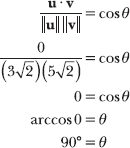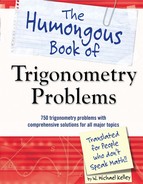Perpendicular vectors
16.31 Describe the geometric relationship between orthogonal vectors.
Orthogonal vectors are perpendicular to each other. Therefore, intersecting orthogonal vectors intersect at right angles.
Note: In Problems 16.32–16.36, you explore four different techniques to verify that vectors u = <3, 3> and v = <5, –5> are orthogonal.
16.32 Plot u and v, and use their direction angles to verify that the vectors are orthogonal.
Plot u and v in the coordinate plane. You will measure the angle between them by calculating the angles each vector forms with the positive x-axis.

Apply the technique demonstrated in Problem 16.19 to calculate the direction angle θ of vector u—the measure of the angle formed by u and the positive x-axis.

Similarly, the angle between v and the positive x-axis measures 45°. The angle between u and v is the sum of those angles: 45° + 45° = 90°. Lines—and vectors—that intersect at 90° angles are perpendicular, so u and v are orthogonal.
Note: In Problems 16.32–16.36, you explore four different techniques to verify that vectors u = <3, 3> and v = <5, –5> are orthogonal.
16.33 Calculate the slopes of the lines that coincide with u and v, and use them to verify that the vectors are orthogonal.
“Coincide with” means “overlap.”
The slope of a vector in component form—and the slope of the line that coincides with that vector—is equal to the y-component of the vector divided by the x-component. Therefore, the slope of the line that coincides with u is 3/3 = 1. The slope of the line that coincides with v is –5/5 = –1.
Perpendicular lines have slopes that are negative reciprocals of each other. Because 1 and –1 are negative reciprocals, they represent the slopes of perpendicular lines. You conclude that u and v are orthogonal.
Note: In Problems 16.32–16.36, you explore four different techniques to verify that vectors u = <3, 3> and v = <5, –5> are orthogonal.
16.34 Apply the standard dot product formula to verify that u and v are orthogonal.
According to the standard dot product formula, <a, b> · <c, d> = ac + bd.

You conclude that u and v are orthogonal because they have a dot product of 0. In fact, any pair of nonzero vectors that have a dot product of 0 are orthogonal.
And vice versa: If vectors are orthogonal, they always have a dot product of 0. This only works for NONZERO vectors. The next problem explains why.
Note: In Problems 16.32–16.36, you explore four different techniques to verify that vectors u = <3, 3> and v = <5, –5> are orthogonal.
16.35 Determine whether u and w = <0, 0> are orthogonal vectors, and explain your answer.
If you calculate the dot product of u and w, the result is 0.

In fact, the dot product of any vector and the zero vector <0, 0> is equal to 0. However, you cannot conclude that u and w are orthogonal based upon the dot product value alone. Recall that orthogonal vectors are perpendicular, so the angle formed by the vectors should equal 90°.
Solve the alternate dot product formula for cos θ to better understand why u and w do not form a 90° angle.

Some textbooks (and teachers) prefer this version of the formula.
Calculate the magnitudes of u and w.

Substitute the dot product and vector magnitudes into the modified dot product formula.

Dividing by 0 is prohibited. Because you cannot calculate θ, you cannot conclude that θ is a right angle. Therefore, u and w are not orthogonal.
Note: In Problems 16.32–16.36, you explore four different techniques to verify that vectors u = <3, 3> and v = <5, –5> are orthogonal.
16.36 Calculate the angle between u and v to verify that the vectors are orthogonal.
Recall that u · v = 0, and according to Problem 16.35, ![]() . Calculate the magnitude of v.
. Calculate the magnitude of v.

Apply the modified dot product formula introduced in Problem 16.35 to compute the angle θ between u and v.

Vectors u and v form a 90° angle, so they are orthogonal.
16.37 Determine whether the vectors <2, –3> and <6, 4> are orthogonal.
Calculate the dot product of the vectors.

Because their dot product is equal to 0, vectors <2, –3> and <6, 4> are orthogonal.
16.38 Given A = (8, –2), B = (6, 1), C = (–3, –7), and D = (4, –4), determine whether ![]() and
and ![]() are orthogonal.
are orthogonal.
Subtract corresponding coordinates to express the vectors in component form.

Calculate the dot product of the vectors.

Vectors ![]() and
and ![]() are not orthogonal because their dot product is not equal to 0.
are not orthogonal because their dot product is not equal to 0.
If a and b are orthogonal vectors, then a · b = 0. Compute the dot product and set it equal to 0.

Solve the equation for c.
![]()
16.40 Given A = (3, 4), B = (12, –10), and z = <5c, –2>, calculate the value of c for which ![]() and z are orthogonal.
and z are orthogonal.
Express ![]() in component form.
in component form.
![]()
Because the vectors are orthogonal, you can set their dot product equal to 0.

Solve for c.

